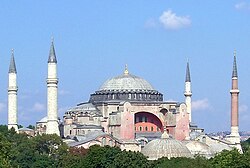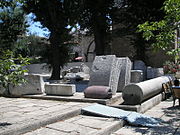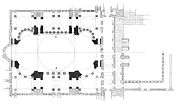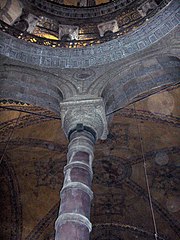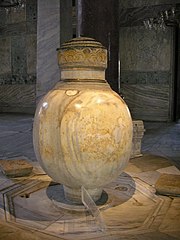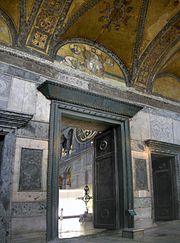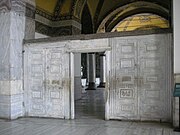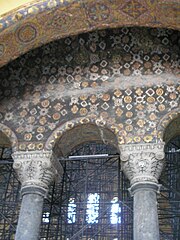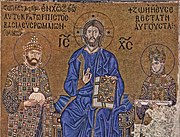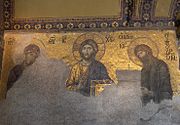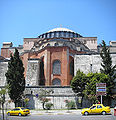Hagia Sophia
From Wikipedia, the free encyclopedia
Hagia Sophia (Turkish: Ayasofya, from the Greek: Αγία Σοφία, "Holy Wisdom"; Latin: Sancta Sophia or Sancta Sapientia) is a former patriarchal basilica, later a mosque, now a museum in Istanbul, Turkey. Famous in particular for its massive dome, it is considered the epitome of Byzantine architecture. It was the largest cathedral in the world for nearly a thousand years, until the completion of the Seville Cathedral in 1520. The current building was originally constructed as a church between A.D. 532 and 537 on the orders of the Byzantine Emperor Justinian, and was in fact the third Church of the Holy Wisdom to occupy the site (the previous two had both been destroyed by riots). It was designed by two architects, Isidore of Miletus and Anthemius of Tralles. The Church contained a large collection of holy relics and featured, among other things, a 50 foot (15 m) silver iconostasis. It was the patriarchal church of the Patriarch of Constantinople and the religious focal point of the Eastern Orthodox Church for nearly 1000 years.
In 1453, Constantinople was conquered by the Ottoman Turks and Sultan Mehmed II ordered the building to be converted into a mosque.[1] The bells, altar, iconostasis, and sacrificial vessels were removed, and many of the mosaics were eventually plastered over. The Islamic features — such as the mihrab, the minbar, and the four minarets outside — were added over the course of its history under the Ottomans. It remained as a mosque until 1935, when it was converted into a museum by the Republic of Turkey.
For almost 500 years the principal mosque of Istanbul, Hagia Sophia served as a model for many of the Ottoman mosques such as the Sultan Ahmed Mosque (Blue Mosque of Istanbul), the Şehzade Mosque, the Süleymaniye Mosque, and the Rüstem Pasha Mosque.
Although it is sometimes referred to as Santa Sophia, the Greek name in full is Ναός τῆς Ἁγίας τοῦ Θεοῦ Σοφίας, Church of the Holy Wisdom of God. It was to this, the Holy Wisdom of God, that the Church was dedicated (Sophia being a Latin phonetic spelling of the Greek word Wisdom). So Santa Sophia should be understood as the title of the church, Holy Wisdom, rather than a reference to some Saint Sophia.
Contents |
[edit] History
[edit] First church
Nothing remains of the first church that was built on this location, known as the Μεγάλη Ἐκκλησία (Megálē Ekklēsíā, "Great Church"), or in Latin "Magna Ecclesia".[2]
As often happened in those days, the site was selected because there had been a pagan temple there.[3] The church was built next to the area where the imperial palace was being developed and next to the smaller church Hagia Eirene, finished first and acting as cathedral until the Hagia Sophia was completed. The Hagia Sophia was inaugurated by Constantius II on 15 February 360. Both churches acted together as the principal churches of the Byzantine Empire.
This church was chronicled by Socrates of Constantinople (380–440), who claimed that it was built by Constantine the Great. It was built as a traditional Latin colonnaded basilica with galleries and a wooden roof. It was preceded by an atrium. This first church was then already claimed to be one of the world's most outstanding monuments.
[edit] Second church
The patriarch of Constantinople, John Chrysostom, came into a conflict with Empress Aelia Eudoxia, wife of the Emperor Arcadius and was sent into exile on 20 June 404. During the subsequent riots, this first church was largely burned down. A second church was ordered by Theodosius II, who inaugurated it on 10 October 415. The basilica with a wooden roof was built by architect Rufinos.
The fire that started during the tumult of the Nika Revolt resulted in the destruction of the (second) Hagia Sophia, which burned down to the ground on 13–14 January 532.
Several marble blocks from this second church have survived to the present day, and they are displayed in the garden of the current (third) church. The blocks were originally part of a monumental front entrance; they were excavated in the western courtyard by A.M. Schneider in 1935. The relief depicting 12 lambs — 12 apostles as well as other remains of this church were discovered during excavation works in 1935. In order not to harm the present Hagia Sophia building, further excavation works were not carried out.
[edit] Third church
On February 23, 532, only a few days after the destruction of the second basilica, Emperor Justinian I took the decision to build a third and entirely different basilica, larger and more majestic than its predecessors.
Justinian chose the physicist Isidore of Miletus and the mathematician Anthemius of Tralles as architects; Anthemius, however, died within the first year. The construction is described by the Byzantine historian Procopius' On Buildings (Peri ktismatōn, Latin: De aedificiis). The emperor had material brought over from all over the empire, such as Hellenistic columns from the temple of Artemis at Ephesus. Large stones were brought from far-away quarries: porphyry from Egypt, green marble from Thessaly, black stone from the Bosporus region and yellow stone from Syria. More than ten thousand people were employed during this construction. This new church was immediately recognized as a major work of architecture, demonstrating the creative insights of the architects. They may have used the theories of Heron of Alexandria to be able to construct a huge dome over such a large open space. The emperor, together with the patriarch Eutychius, inaugurated the new basilica on December 27, 537 with much pomp and circumstance. The mosaics inside the church were, however, only completed under the reign of Emperor Justin II (565–578).
Earthquakes in August 553 and on December 14, 557 caused cracks in the main dome and the eastern half-dome to appear. The main dome collapsed completely during an earthquake on May 7, 558, destroying the ambon, the altar and the ciborium over it. The emperor ordered an immediate restoration. He entrusted it to Isodorus the Younger, nephew of Isidore of Miletus. This time he used lighter materials and elevated the dome by 6.25 metres (20.5 ft), thus giving the building its current interior height of 55.6 metres (182 ft). [4]. This reconstruction, giving the church its present 6th century form, was completed in 562. The Byzantine poet Paul the Silentiary composed an extant, long epic poem, known as Ekphrasis, for the rededication of the basilica, presided over by Patriarch Eutychius, on 23 December 562.
Hagia Sophia was the seat of the Orthodox patriarch of Constantinople and a principal setting for Byzantine imperial ceremonies, such as coronations. The basilica also offered asylum to wrongdoers. Foreign visitors were deeply impressed.
In 726 the Emperor Leo the Isaurian issued a series of edicts against the veneration of images, ordering the army to destroy all icons (iconoclasm). At that time, all religious pictures and statues were removed from the Hagia Sophia. After a brief reprieve under Empress Irene (797–802), the iconoclasts made a comeback. Emperor Theophilus (829–842) was strongly influenced by Islamic art,[citation needed] which forbids graven images. He had a two-winged bronze door with his monograms installed at the southern entrance of the church.
The basilica suffered damage, first by a great fire in 859, and again by an earthquake on January 8, 869 that made a half-dome collapse. Emperor Basil I ordered the church to be repaired.
After the great earthquake of 25 October 989, which ruined the great dome of Hagia Sophia, the Byzantine emperor Basil II asked for the Armenian architect Trdat, creator of the great churches of Ani and Agine, to repair the dome.[5] His main repairs were to the western arch and a portion of the dome. The extent of the church's destruction meant that reconstruction lasted six years. The church was re-opened on 13 May 994.
In his book De caerimoniis aulae Byzantinae (Book of Ceremonies), emperor Constantine VII (913–919) wrote about all the details of the ceremonies held in the Hagia Sophia by the emperor and the patriarch.

At the capture of Constantinople during the Fourth Crusade, the church was ransacked and desecrated by the Latin Christians. The Byzantine historian Niketas Choniates described the capture of Constantinople. Many relics from the church, such as a stone from the tomb of Jesus, the Virgin Mary's milk, the shroud of Jesus, and bones of several saints, were sent to churches in the West and can be seen now in various museums in the West. During the Latin occupation of Constantinople (1204–1261) the church became a Roman Catholic cathedral. Baldwin I of Constantinople was crowned emperor on 16 May 1204 in the Hagia Sophia, at a ceremony which closely followed Byzantine practices. Enrico Dandolo, the Doge of Venice who commanded the sack and invasion of the city by the Latin Crusaders in 1204, is buried inside the church. The tomb inscription carrying his name, which has become a part of the floor decoration, was spat upon by many of the angry Byzantines who recaptured Constantinople in 1261. However, restoration carried out during the period 1847–1849 cast doubt upon the authenticity of the doge's grave. It is more likely a symbolic burial site to keep alive his memory.
After the recapture in 1261 by the Byzantines, the church was in a dilapidated state. The four buttresses in the west were probably built during this time. In 1317, emperor Andronicus II ordered four new buttresses to be built in the eastern and northern parts of the church. After new cracks had developed in the dome after the earthquake of October 1344, several parts of the building collapsed on 19 May 1346. After that, the church remained closed until 1354, when repairs were undertaken by the architects Astras and Peralta.
[edit] Mosque
Immediately after the Ottoman Turks conquered Constantinople (Istanbul) in 1453, the Hagia Sophia was converted to the Ayasofya Mosque[1] as the symbol of the conquest. At that time, the church was very dilapidated. Several of its doors had fallen off. This condition was described by several Western visitors, such as the Córdoban nobleman Pero Tafur[6] and the Florentine Cristoforo Buondelmonti.[7] The sultan Mehmed II ordered the immediate cleanup of the church and its conversion to a mosque. The next sultan Bayezid II built a new minaret, replacing the one built by his father.
In the 16th century the sultan Suleiman the Magnificent (1520–1566) brought back two colossal candles from his conquest of Hungary. They were placed on both sides of the mihrab. During the reign of Selim II (1566–1577), the building started showing signs of fatigue and was extensively strengthened with the addition of structural supports to its exterior by the great Ottoman architect Sinan, who is also considered one of the world's first earthquake engineers.[8] In addition to strengthening the historic Byzantine structure, Sinan built the two additional large minarets at the western end of the building, the original sultan's loge, and the mausoleum of Selim II to the southeast of the building (then a mosque) in 1577. The mausoleums of Murad III and Mehmed III were built next to it in the 1600s.
Later additions were the sultan's gallery, a minbar decorated with marble, a dais for a sermon and a loggia for a muezzin.
The sultan Murad III (1574–1595) had two large alabaster Hellenistic urns transported from Pergamon and placed on two sides of the nave.
Sultan Mahmud I ordered the restoration of the building in 1739 and added a medrese (a Koranic school, now the library of the museum), a soup kitchen (for distribution to the poor) and a library, and in 1740 a fountain for ritual ablutions (Şadirvan), thus transforming it into a külliye, i.e. a social complex. At the same time a new sultan's gallery and a new mihrab were built inside.
The most famous restoration of the Hagia Sophia was ordered by Sultan Abdülmecid and completed by eight hundred workers between 1847 and 1849, under the supervision of the Swiss-Italian architect brothers Gaspare and Giuseppe Fossati. The brothers consolidated the dome and vaults, straightened the columns, and revised the decoration of the exterior and the interior of the building. The mosaics in the upper gallery were cleaned. The old chandeliers were replaced by new pendant ones. New gigantic circular-framed disks were hung on columns. They were inscribed with the names of Allah, the prophet Muhammad, the first four caliphs Abu Bakr, Umar, Uthman and Ali, and the two grandchildren of Mohammed: Hassan and Hussain, by the calligrapher Kazasker İzzed Effendi (1801–1877). In 1850 the architect Fossati built a new sultan's gallery in a Neo-Byzantine style connected to the royal pavilion behind the mosque. Outside the Hagia Sophia, a timekeeper's building and a new medrese were built. The minarets were altered so that they were of equal height. When the restoration was finished, the mosque was re-opened with ceremonial pomp on 13 July 1849.
[edit] Museum
In 1935, the first Turkish President and founder of the Republic of Turkey, Mustafa Kemal Atatürk, transformed the building into a museum. The carpets were removed and the marble floor decorations appeared for the first time in centuries, while the white plaster covering the mosaics was painstakingly removed by expert restorers. [9]
[edit] Architecture
Hagia Sophia is one of the greatest surviving examples of Byzantine architecture. Of great artistic value was its decorated interior with mosaics and marble pillars and coverings. The temple itself was so richly and artistically decorated that Justinian proclaimed, "Solomon, I have outdone thee!" (Νενίκηκά σε Σολομών). Justinian himself had overseen the completion of the greatest cathedral ever built up to that time, and it was to remain the largest cathedral for 1,000 years up until the completion of the cathedral in Seville in Spain.
Justinian's basilica was at once the culminating architectural achievement of late antiquity and the first masterpiece of Byzantine architecture. Its influence, both architecturally and liturgically, was widespread and enduring in the Eastern Orthodox, Roman Catholic, and Muslim worlds alike. The largest columns are about 19 or 20 meters tall. They are at least 1.5 meters diameter. They are made out of granite, the largest weighing well over 70 tons. Under Justinian's orders, eight Corinthian columns were disassembled from Baalbek, Lebanon and shipped to Constantinople for the construction of Hagia Sophia.[10]
The vast interior has a complex structure. The vast nave is covered by a central dome which has a maximum diameter of 31.24 metres (102 ft 6 in) and a height from floor level of 55.6 metres (182 ft 5 in), about one fourth smaller and greater, respectively, than the dome of the Pantheon. The dome seems rendered weightless by the unbroken arcade of 40 arched windows under it, which help flood the colourful interior with light. Due to consecutive repairs in the course of its history, the dome has lost its perfect circular base and has become somewhat elliptical with a diameter varying between 31.24 m (102 ft 6 in) and 30.86 m (101 ft 3 in).
The dome is carried on pendentives — four concave triangular sections of masonry which solve the problem of setting the circular base of a dome on a rectangular base. At Hagia Sophia the weight of the dome passes through the pendentives to four massive piers at the corners. Between them the dome seems to float upon four great arches. These were reinforced with buttresses during Ottoman times, under the guidance of the architect Sinan.
At the western (entrance) and eastern (liturgical) ends, the arched openings are extended by half domes carried on smaller semi-domed exedras. Thus a hierarchy of dome-headed elements builds up to create a vast oblong interior crowned by the main dome, a sequence unexampled in antiquity. Despite all these measures, the weight of the dome remained a problem, which was solved by adding buttresses from the outside.
All interior surfaces are sheathed with polychrome marbles, green and white with purple porphyry and gold mosaics, encrusted upon the brick. This sheathing camouflaged the large pillars, giving them, at the same time, a brighter aspect.
On the exterior, simple stuccoed walls reveal the clarity of massed vaults and domes. The yellow and red colour of the exterior was added by the architect Fossati during the restorations in the 19th century.
[edit] Dome
The dome of Hagia Sophia has spurred particular interest for many art historians, architects and engineers because of the innovative way the original architects envisioned the dome. The dome is supported by pendentives which had never been used before the building of this structure. The pendentive enables the dome to transition gracefully into the square shape of the piers below. The pendentives not only achieve a pleasing aesthetic quality, but they also restrain the lateral forces of the dome and allow the weight of the dome to flow downward.
Although this design stabilizes the dome and the surrounding walls and arches, the actual construction of the walls of Hagia Sophia weakened the overall structure. The bricklayers used more mortar than brick, which weakened the walls. The structure would have been more stable if the builders at least let the mortar cure before they began the next layer; however, they did not do this. When the dome was placed atop the building, the weight of the dome caused the walls to lean outward because of the wet mortar underneath. When Isidorus the Younger rebuilt the original dome, he had to first build up the interior of the walls so that they were vertical in order to support the weight of the new dome. Another probable change in the design of the dome when it was rebuilt was the actual height of the dome. Isidore the Younger raised the height of the dome by approximately twenty feet so that the lateral forces would not be as strong and the weight of the dome would flow more easily down the walls.
A second interesting fact about the original structure of the dome was how the architects were able to place forty windows around the base of the dome. Hagia Sophia is famous for the mystical quality of light that reflects everywhere in the interior of the nave, which gives the dome the appearance of hovering above the nave. This design is possible because the dome is shaped like a scalloped shell or the inside of an umbrella with ribs that extend from the top of the dome down to the base. These ribs allow the weight of the dome to flow between the windows, down the pendentives, and ultimately to the foundation.
The unique character of the design of Hagia Sophia shows how this structure is one of the most advanced and ambitious monuments of late antiquity.
[edit] Marble jar
The marble jar was brought from Pergamon during the reign of Sultan Murad III. Originally from the Hellenistic period, it was carved from a single block of marble.
[edit] Narthex and portals
The Imperial Gate was the main entrance between the exo- and esonarthex. It was reserved only for the emperor. The Byzantine mosaic above the portal depicts Christ and Emperor Leo VI the Wise.
A long ramp from the northern part of the outer narthex leads up to the upper gallery.
[edit] Upper Gallery
The upper gallery is laid out in a horseshoe shape that encloses the nave until the apse. Several mosaics are preserved in the upper gallery, an area traditionally reserved for the empress and her court. The best-preserved mosaics are located in the southern part of the gallery.
[edit] Loge of the Empress
The Loge of the Empress is located in the centre of the upper enclosure, or gallery, of the Hagia Sophia. From there the empress and the court-ladies would watch the proceedings down below. A round, green stone marks the spot where the throne of the empress stood.
[edit] Marble Door
The Marble Door inside the Hagia Sophia is located in the southern upper enclosure, or gallery. It was used by the participants in synods, they entered and left the meeting chamber through this door.
[edit] Decorations
Originally, under Justinian's reign, the interior decorations consisted of abstract designs of the marble slabs on the walls and mosaics on the curving vaults. Of these, one can still see the two archangels Gabriel and Michael in the spandrels of the bema. There were already a few figurative decorations, as attested by the eulogy of Paul the Silentiary. The spandrels of the gallery are revetted in opus sectile, showing patterns and figures of flowers and birds in precisely cut pieces of white marble set against a background of black marble. In later stages figurative mosaics were added, which were destroyed during the iconoclastic controversy (726–843). Present mosaics are from the post-iconoclastic period. The number of treasures, relics and miracle-working, painted icons of the Hagia Sophia grew progressively richer into an amazing collection. Apart from the mosaics, a large number of figurative decorations were added during the second half of the ninth century: an image of Christ in the central dome; Orthodox saints, prophets and Church Fathers in the tympana below; historical figures connected with this church, such as Patriarch Ignatius; some scenes from the gospel in the galleries.
[edit] Mosaics
The church was richly decorated with mosaics throughout the centuries. They either depicted the Virgin Mother, Jesus, Saints, or emperors and empresses. Other parts were decorated in a purely decorative style with geometric patterns.
During the Sack of Constantinople in 1204, the Latin Crusaders vandalized the valuable items in every important Byzantine structure of the city, including the golden mosaics of the Hagia Sophia. Much of these valuable items were shipped to Venice, whose Doge, Enrico Dandolo, had organized the invasion and sack of Constantinople.
Following the building's conversion into a mosque in 1453, many of its mosaics were covered with plaster, due to Islam's ban on representational imagery. This process was not completed at once, and reports exist from the 17th century in which travellers note that they could still see Christian images in the former church. In 1847–49, the building was restored by two Swiss brothers, Gaspare and Giuseppe Fossati, and Sultan Abdülmecid allowed them to also document any mosaics they might discover during this process. This work did not include repairing the mosaics and after recording the details about an image, the Fossatis painted it over again. This work included covering the previously uncovered faces of two seraphim mosaics located in the centre of the building. The building currently features a total of four of these images and two of them are restorations in paint created by the Fossatis to replace two images of which they could find no surviving remains. In other cases, the Fossatis recreated damaged decorative mosaic patterns in paint, sometimes redesigning them in the process. The Fossati records are the primary sources about a number of mosaic images now believed to have been completely or partially destroyed in an earthquake in 1894. These include a great mosaic of Christ Pantocrator in the dome, a mosaic over a now unidentified Door of the Poor, a large image of a jewel-encrusted cross and a large number of images of angels, saints, patriarchs, and church fathers. Most of the missing images were located in the building's two tympana. The Fossatis also added a pulpit (minbar) and the four large medallions on the walls of the nave bearing the names of Muhammad and Islam's first caliphs.
[edit] Imperial Gate mosaic
- Imperial Gate mosaics: located in the tympanum above the gate, used only by the emperors when entering the church. Based on style analysis, it has been dated to the late 9th or early 10th century. The emperor with a nimbus or halo could possibly represent emperor Leo VI the Wise or his son Constantine VII Porphyrogenitus bowing down before Christ Pantocrator, seated on a jeweled throne, giving His blessing and holding in His left hand an open book.[11] The text on the book reads as follows : "Peace be with you. I am the light of the world". (John 20:19; 20:26; 8:12) On each side of Christ's shoulders is a circular medallion : on His left the Archangel Gabriel (founder of the church), holding a staff, on His right His Mother Mary. These mosaics express the timeless power bestowed by Christ on the Byzantine emperors.
[edit] Southwestern entrance mosaic
- Southwestern entrance mosaics, situated in the tympanum of the southwestern entrance, date from 944. They were rediscovered during the restorations of 1849 by Fossati. The Virgin sits on a throne without a back, her feet resting on a pedestal, embellished with precious stones. The Child Christ sits on her lap, giving His blessing and holding a scroll in His left hand. On her left side stands emperor Constantine in ceremonial attire, presenting a model of the city to Mary. The inscription next to him says : "Great emperor Constantine of the Saints". On her right side stands emperor Justinian I, offering a model of the Hagia Sophia. The medallions on both sides of the Virgin's head carry the monograms MP and ΘY, an abbreviation of "Mētēr" and "Theou", meaning "Mother of God".
[edit] Apse mosaics
- Virgin and Child: this was the first of the post-iconoclastic mosaics. It was inaugurated on 29 March 867 by Patriarch Photius and the emperors Michael III and Basil I. This mosaic is situated in a high location on the half dome of the apse. Mary is sitting on a throne without a back, holding the Child Jesus on her lap. Her feet rest on a pedestal. Both the pedestal and the throne are adorned with precious stones. These mosaics are believed to be a reconstruction of the mosaics of the sixth century that were previously destroyed during the iconoclastic era. The mosaics are set against the original golden background of the 6th century. The portraits of the archangels Gabriel and Michael (largely destroyed) in the bema of the arch also date from the 9th century.
[edit] Emperor Alexander mosaic
- The Emperor Alexander mosaic is not easy to find for the first-time visitor, located in the second floor in a dark corner of the ceiling. It depicts Emperor Alexander in full regalia, holding a scroll in his right hand and a globus cruciger in his left. A drawing by Fossati showed that the mosaic survived until 1849, and that Thomas Whittemore, founder of the Byzantine Institute of America who was granted permission to preserve the mosaics, assumed that is had been destroyed in the earthquake of 1894. Eight years after his death, the mosaic was discovered in 1958 largely through the researches of Robert Van Nice. Unlike most of the other mosaics in Hagia Sophia, which had been covered over by ordinary plaster, the Alexander mosaic was simply painted over and reflected the surrounding mosaic patterns and thus was well hidden. It was duly cleaned by the Byzantine Institute's successor to Whittemore, Ernest J. W. Underwood. [12]
[edit] Empress Zoe mosaics
- The Empress Zoe mosaics on the eastern wall of the southern gallery date from the 11th century. Christ Pantocrator, clad in the dark blue robe (as always the custom in Byzantine art), is seated in the middle against a golden background, giving His blessing with the right hand and holding the Bible in His left hand. On either side of His head are the monograms IC and XC, meaning Iēsous Khristos. He is flanked by Constantine IX Monomachus and Empress Zoe, both in ceremonial costumes. He is offering a purse, as symbol of the donation he made to the church, while she is holding a scroll, symbol of the donations she made. The inscription over the head of the emperor says : "Constantine, pious emperor in Christ the God, king of the Romans, Monomachus". The inscription over the head of the empress reads as follows : "Zoë, the very pious Augusta". The previous heads have been scraped off and replaced by the three present ones. Perhaps the earlier mosaic showed her first husband Romanus III Argyrus or her adopted son Michael IV. Another theory is that these mosaics were made for an earlier emperor and empress, with their heads changed into the present ones.
[edit] Comnenus mosaics
- The Comnenus mosaics, equally located on the eastern wall of the southern gallery, date from 1122. The Virgin Mary is standing in the middle, depicted, as usual in Byzantine art, in a dark blue gown. She holds the Child Christ on her lap. He gives His blessing with His right hand while holding a scroll in His left hand. On her right side stands emperor John II Comnenus, represented in a garb embellished with precious stones. He holds a purse, symbol of an imperial donation to the church. Empress Irene stands on the left side of the Virgin, wearing ceremonial garments, offering a document. Their eldest son Alexius Comnenus is represented on an adjacent pilaster. His mournful features, reflect his death from tuberculosis in the same year. In this panel one can already see a difference with the Empress Zoe mosaics that is one century older. There is a more realistic expression in the portraits instead of an idealized representation. The empress is shown with plaited blond hair, rosy cheeks and grey eyes, revealing her Hungarian descent. The emperor is depicted in a dignified manner.
[edit] Deësis mosaic
- The Deësis ('Δέησις' in Greek, meaning Entreaty) mosaic probably dates from 1261. It was commissioned to mark the end of 57 years of Roman Catholic use and the return to the Orthodox faith. It is the third panel situated in the imperial enclosure of the upper galleries. It is widely considered the finest in Hagia Sophia, because of the softness of the features, the humane expressions and the tones of the mosaic. The style is close to that of the Italian painters of the late 13th or early 14th century, such as Duccio. In this panel the Virgin Mary and John the Baptist (Ioannes Prodromos), both shown in three-quarters profile, are imploring the intercession of Christ Pantocrator for humanity on Judgment Day. The bottom part of this mosaic is badly deteriorated, probably due to rain since the mosaic is next to the windows. This mosaic is considered as the beginning of the Renaissance in Byzantine pictorial art.
[edit] Northern tympanon mosaics

- The northern tympanon mosaics feature various saints. They have been able to survive due to the very high and unreachable location. They depict Saints John Chrysostom and Ignatius the Younger standing, clothed in white robes with crosses, and holding richly jewelled Holy Bibles. The names of each saint is given around the statues in Greek, in order to enable an identification for the visitor. The other mosaics in the other tympani have not survived probably due to the frequent earthquakes as opposed to any deliberate destruction by the Ottoman conquerors.
[edit] 20th-century restoration
A large number of mosaics were uncovered in the 1930s by a team from the Byzantine Institute of America led by Thomas Whittemore. The team chose to let a number of simple cross images remain covered by plaster, but uncovered all major mosaics found.
Due to its long history as both a church and a mosque, a particular challenge arises in the restoration process. The Christian iconographic mosaics are being gradually uncovered. However, in order to do so, important, historic Islamic art would have to be destroyed. Restorers have attempted to maintain a balance between both Christian and Islamic cultures. In particular, much controversy rests upon whether the Islamic calligraphy on the dome of the cathedral should be removed, in order to permit the underlying Pantocrator mosaic of Christ as Master of the World, to be exhibited (assuming the mosaic still exists).
[edit] Minarets
One of the minarets (at southwest) was built from red brick while the other three were built from white marble; of which the slender one at northeast was erected by Sultan Bayezid II while the two larger minarets at west were erected by Sultan Selim II and designed by the famous Ottoman architect Sinan.[citation needed]
[edit] Gallery
Exterior
Interior
|
Stele of St Gregory Thaumaturgus that is ascribed with miraculous powers |
|||
|
One of the runic inscriptions in Hagia Sophia, probably inscribed by members of the Varangian Guard |
Upper Gallery
|
Mosaic of Emperor Alexander holding a scroll and globus cruciger |
|||
Islamic elements
|
Iznik tiles showing the Kaaba ( located next to the apse) |
|||
|
Illuminated Iraqi manuscript from the De Materia Medica (1224 AD), kept in the library |
Historical drawings
[edit] Footnotes
- ^ a b http://archnet.org/library/sites/one-site.jsp?site_id=2966
- ^ Alessandro E. FONI, George PAPAGIANNAKIS, Nadia MAGNENAT-THALMANN. "Virtual Hagia Sophia: Restitution, Visualization and Virtual Life Simulation" (PDF). http://www.virtualworldheritage.org/papers/3181_976-Virtual_Hagia_Sophia.pdf. Retrieved on 2007-07-03.
- ^ Hagia Sophia accessed September 13, 2007
- ^ Emporis: Haghia Sophia
- ^ Lynn Jones. Between Islam and Byzantium, Agh'tamar and the visual construction of medieval Armenian Rulership. Ashgate Publishing Limited, 2007, 98.
- ^ Pero Tafur, Travels and Adventures, trans. M. Letts (London, 1926), 138–48;
- ^ G. Gerola, “Le vedute di Costantinopoli di Cristoforo Buondemonti,” SBN 3 (1931): 247–79.
- ^ Mungan, I. (2004). Hagia Sophia and Mimar Sinan. Mungan & Wittek (eds); Taylor & Francis Group, London. pp. 383–384. ISBN 90 5809 642 4. http://books.google.be/books?hl=nl&lr=&id=6j5nuvAd44QC&oi=fnd&pg=PA383&dq=Sinan+earthquake+%22Hagia+Sophia%22&ots=HFASNZ8r-P&sig=zS-hO7E6RtwfhN55LGn6ulpRIE0#PPA383,M1.
- ^ http://www.islamonline.net/servlet/Satellite?c=Article_C&cid=1182170385033&pagename=Zone-English-ArtCulture%2FACELayout Hagia Sophia
- ^ Baalbek keeps its secrets
- ^ The Hagia Sophia Church
- ^ Lord Kinross, Hagia Sophia: A History of Constantinople, Newsweek, New York, 1972, p.132-133.
[edit] See also
- Church of the Holy Apostles — formerly the second most important church of Constantinople
- Hagia Irene — neighbouring church
- Chora Church
- Pammakaristos Church
- Haseki Hürrem Sultan Hamamı — bath commissioned by Roxelana for the Hagia Sophia community
- Caferağa Medresseh — former Koranic school next to Hagia Sophia
- Soğukçeşme Sokağı — historical street between the Hagia Sophia and Topkapı Palace
- Saint Sophia Cathedral in Kiev
- Saint Sophia Cathedral in Novgorod
- Saint Sophia Cathedral in Polotsk
- Saint Clement Catholic Church, Chicago
- List of megalithic sites
[edit] References
- Mainstone, Rowland J. (1997). Hagia Sophia: Architecture, Structure, and Liturgy of Justinian's Great Church (reprint edition). W W Norton & Co Inc.. ISBN 0-500-27945-4..
- Hagia Sophia Church, also known as Church of Holy Wisdom.
- Akṣit, Ilhan. Hagia Sophia. Akṣit Kültür ve Turizm Yayincilik. ISBN 975-7039-07-1.
- Turner, J., Grove Dictionary of Art, Oxford University Press, USA; New Ed edition (January 2, 1996); ISBN 0-19-517068-7
[edit] Literature
- Joseph D. Alchermes: Art and Architecture in the Age of Justinian, in: Michael Maas (Ed.): The Cambridge Companion to the Age of Justinian. Cambridge 2005, pg. 343–375.
- Balfour, John Patrick Douglas (1972). Hagia Sophia. W.W. Norton & Company. ISBN 978-0882250144.
- Cimok, Fatih (2004). Hagia Sophia. Milet Publishing Ltd. ISBN 978-9757199618.
- Doumato, Lamia (1980). The Byzantine church of Hagia Sophia: Selected references. Vance Bibliographies. ASIN B0006E2O2M.
- Goriansky, Lev Vladimir (1933). Haghia Sophia: analysis of the architecture, art and spirit behind the shrine in Constantinople dedicated to Hagia Sophia. American School of Philosophy. ASIN B0008C47EA.
- Harris, Jonathan, Constantinople: Capital of Byzantium. Hambledon/Continuum (2007). ISBN 978 1847251794
- Howland Swift, Emerson (1937). The bronze doors of the gate of the horologium at Hagia Sophia. University of Chicago. ASIN B000889GIG.
- Kahler, Heinz (1967). Haghia Sophia. Praeger. ASIN B0008C47EA.
- Kinross, Lord (1972). Hagia Sophia, Wonders of Man. Newsweek. ASIN B000K5QN9W.
- Kleinbauer, W. Eugene; Anthony White (2007). Hagia Sophia. London: Scala Publishers. ISBN 978-1857593082.
- Kleinbauer, W. Eugene (2000). Saint Sophia at Constantinople: Singulariter in Mundo (Monograph (Frederic Lindley Morgan Chair of Architectural Design), No. 5.). William L. Bauhan. ISBN 978-0872331235.
- Krautheimer, Richard (1984). Early Christian and Byzantine Architecture. New Haven, CT: Yale University Press. ISBN 978-0300052947.
- Mainstone, R. J. (1997). Hagia Sophia: Architecture, Structure, and Liturgy of Justinian's Great Church. London: Thames & Hudson. ISBN 978-0500279458.
- Mainstone, Rowland J. (1988). Hagia Sophia. Architecture, structure and liturgy of Justinian's great church. London: Thames & Hudson. ISBN 0-500-34098-6.
- Mango, Cyril; Ahmed Ertuğ (1997). Hagia Sophia. A vision for empires. Istanbul.
- Nelson, Robert S. (2004). Hagia Sophia, 1850–1950: Holy Wisdom Modern Monument. Chicago: University Of Chicago Press. ISBN 978-0226571713.
- Özkul, T. A. (2007). Structural characteristics of Hagia Sophia: I-A finite element formulation for static analysis. Elsevier.
- Swainson, Harold (2005). The Church of Sancta Sophia Constantinople: A Study of Byzantine Building. Boston, MA: Adamant Media Corporation. ISBN 978-1402183454.
- Yucel, Erdem (2005). Hagia Sophia. Scala Publishers. ISBN 978-1857592504.
- Hagia Sophia from the Age of Justinian to the Present. Princeton Architectural. 1992. ISBN 978-1878271112.
[edit] Articles
- Bordewich, Fergus M., "A Monumental Struggle to Preserve Hagia Sophia", Smithsonian magazine, December 2008
[edit] Mosaics
- MacDonald, William Lloyd (1951). The uncovering of Byzantine mosaics in Hagia Sophia. Archaeological Institute of America. ASIN B0007GZTKS.
- Mango, Cyril (1972). The mosaics of St. Sophia at Istanbul: The church fathers in the north Tympanum. Dumbarton Oaks Center for Byzantine Studies. ASIN B0007CAVA0.
- Mango, Cyril (1968). The Apse mosaics of St. Sophia at Istanbul: Report on work carried out in 1964. Johnson Reprints. ASIN B0007G5RBY.
- Mango, Cyril; Heinz Kahler (1967). Hagia Sophia: With a Chapter on the Mosaics. Praeger. ASIN B0000CO5IL.
- Teteriatnikov, Natalia B. (1998). Mosaics of Hagia Sophia, Istanbul: The Fossati Restoration and the Work of the Byzantine Institute. Dumbarton Oaks Research Library and Collection. ISBN 978-0884022640.
- Yücel, Erdem (1988). The mosaics of Hagia Sophia. Efe Turizm. ASIN B0007CBGYA.
[edit] External links
| Wikimedia Commons has media related to: Hagia Sophia |
- Turkish Ministry of Culture and Tourism | Hagia Sophia Virtual Tour
- Byzantium 1200 | Hagia Sophia computer reconstruction
- Contemporary description by Procopius, Buildings (De Aedificiis), published in 561.
- Hagia Sophia history and info.
- Interactive floor plan.
- Ecumenical Patriarchate | Hagia Sophia — Photos
- Agia Sofia — history and pictures
- Hagia Sofia 3 galleries of its architecture, stone decoration and mosaics
[edit] Mosaics
- Mosaic Art Source | Hagia Sophia — detailed views
- Deesis Mosaic of Christ from the South Gallery of Hagia Sophia.
|
|||||
